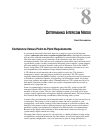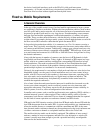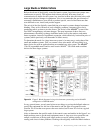
116 Handbook of Intercom Systems Engineering
Determining Intercom Needs, two-wire, four-wire, or both?
In determining intercom needs for a specific application, we begin by first giving
examples of intercom requirements. Then, we will attempt to specify an RTS
™
intercom
system to fill that requirement. Although specific applications are presented, we finish
with a general discussion of how to determine whether a given system should be two-wire,
four-wire, or some combination of each system.
Before we begin, we should again mention that although analog two-wire conference
intercoms continue to carry basic communications for many smaller production facilities,
digitally controlled matrix systems offer a range of flexible alternatives. By integrating
various forms of communications features, the four-wire matrix system for larger
applications makes the difference between confusion and a successful production session.
Small Studio or ENG Vehicle
Previously, we presented the example of the ENG vehicle with its small two-wire system.
We have also determined this application requires at least two forms of communications:
conference and IFB
To fill the need of a small studio or ENG vehicle, we propose the MCE325 system with its
inherent simple IFB (meaning no tally or priority). As shown below, the MCE325 and its
associated components make an excellent choice for this application. The powerful
MCE325 intercom panel has the capability to produce two conference channels and two
IFB channels, which is perfect for the electronic news gatherer. There are many other
configurations available in the highly versatile and user programmable MCE325,
including four-wire, vox, relays for radios, and many others.
Note
A small four-wire matrix system such as the Zeus could have been specified, but probably
would have been overkill for this application.
In essence, the client now has saved several thousand dollars using a small, but extremely
versatile intercom system.
Figure 2. The Model MCE325 provides the intercom backbone for the typical ENG
vehicle or small studio.
MCE325 Modular Programmable Station
This unit is available in many physical configurations. For this application, we specify the
MCE325-K. The ‘K’ designator includes the MCE325, MCP1 (1U rack kit), MCS325
modular speaker, and the MCP6 removable panel microphone. The four talk buttons on
the panel are Talk1, Talk2, IFB1, and IFB2. Talk 1 and 2 operate the two conference
channels. The rear panel channel 1-2 connector ties to the TW5W 1x5 Splitter while its
loop-through connects to the PS15. The channel 3-4 connector ties to the IFB325 talent
stations. The MCE325 has a headset connector to allow the director to use the system
privately, if desired. Other MCE325’s can be interconnected to the director’s panel. IFB
capabilities are retained on other MCE325 panels via a special keying circuit that allows
the slave units to operate the master unit IFB.
PS15 Power Supply/MCP2 Rack Kit
The PS-15 power supply and its MCP2 single component rack kit (not shown) provide
operating power for both the BP325 programmable belt packs and IFB talent stations.


















